Vanya Silks - The Wild Silks of India
APPLICATION FOR LICENCING USE OF VANYA SILK LOGO FOR GENERIC AND BRAND PROMOTION
APPLICATION FOR RENEWAL OF LICENCING USE OF VANYA SILK LOGO FOR GENERIC AND BRAND PROMOTION
- INTRODUCTION
Natural Silk: Natural Silk is insect fibre. It comes from the silkworm cocoon that the silkworm spins around itself to form its cocoon. A single filament from a cocoon can be as long as 1600 meters. It is considered an animal fibre because it has a protein structure. Just like other animal fibres silk does not conduct heat, and acts as an excellent insulator to keep our bodies warm in the cold weather and cool in the hot weather.
Silk has luster, drape and strength. There are three grades of silk; each is a product of the three different stages of silk processing. The unwound filament makes the finest quality silk, and is referred to as reeled silk. It is satiny smooth and pure white. Remaining silk from the reeling process becomes the raw material for carded or combed, spun silk yarn. The short fibres left behind after the carding or combing process are used to make noil yarn, a richly textured nubbly silk.
India produces all four varieties of natural silks viz., Mulberry silk, Tasar silk, Muga silk and Eri silk. The Tasar, Eri and Muga silk are non mulberry silks which are wild silks and also known as Vanya Silks.
- THE WILD SILKS OF INDIA - TASAR, ERI and MUGA
Vanya silks arouse the creative passion in designers for innovation, ingenuity and exclusively – naturally and spontaneously. Vanya silks portray the rich crafts, culture and folklore of the North Eastern and tribal zones of Central, eastern India and sub Himalayan region. They are distinguish in looks and feel as they are procured from the wild silkworms that feed on leaves of castor, kesseru, payam, som, sualu, oak, arjun, asan, sal etc… in the open jungles, imbibing the unevenness of nature, and reflecting it in the silks they produce.
In unparallel textures, with natural sheen, easy affinity for natural dyes, light in weight and high in moisture absorbency, and with baffling thermal properties…warm in winter and cool in summer, products of rich, salubrious climate and nourishing vegetation, each of the Vanya silks has its own unique beauty and ethnic culture. They are distinguished in four different forms: muga, tropical tasar, oak tasar and eri. They are the magnificent gifts of nature to genius of global designers, to explore and create various designs for garments, life style products and home furnishings for sophisticated homes, haute couture as far as artistic imagination can stretch.
Irresistible Eri Silk: Also known as endi or errandi, this silk is produced by the eri silkworm (Philosamia ricini).
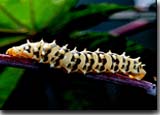
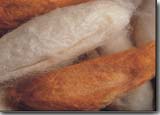
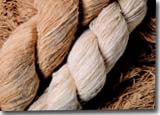 These worms feed mainly on Castor and Kesseru. As eri cocoons are open ended, the yarn is spun. Interestingly, in many parts of the North-East, eri cocoons are produced for their edible pupae and silk is the by-product. Elegantly designed eri shawls and chaddars are quite popular because of their thermal properties. They can be blended with cotton, wool, jute or even mulberry silk to create exotic fabrics for use in jackets, or suiting material, or for producing a variety of furnishings, making it an interior decorator’s delight.
These worms feed mainly on Castor and Kesseru. As eri cocoons are open ended, the yarn is spun. Interestingly, in many parts of the North-East, eri cocoons are produced for their edible pupae and silk is the by-product. Elegantly designed eri shawls and chaddars are quite popular because of their thermal properties. They can be blended with cotton, wool, jute or even mulberry silk to create exotic fabrics for use in jackets, or suiting material, or for producing a variety of furnishings, making it an interior decorator’s delight.Tantalizing Tasar: Tasar silk is produced by tasar silkworms (Antheraea mylitta and Antheraea proylei) that feed mainly on the leaves of Asan, Arjun and Oak. India is the second largest producer of tasar silk and the exclusive producer of Indian tasar


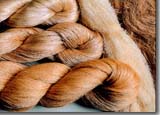
(also known as tropical tasar), which is largely tended by tribals in the Gondwana belt. Oak tasar (also known as temperate tasar) is mainly used for furnishing, dress materials and sarees. Bomkai, Paithani, Ikkat (tie & dye) and Katki are some popular fabrics produced using tasar silks. Bafta is a popular blend of tasar and cotton. Shawls and mufflers are also produced using a blend of oak tasar and other natural fibers like wool, cotton, etc. Tasar silk is ideal for making jackets for men and women or traditional costumes like the ‘salwar-kurta’. This silk can be styled into beautiful dresses, stoles and scarves. Tasar fabric can also be printed, hand-painted, or, even embroidered into traditional sarees and beautiful dress-materials. In fact, in India, it is said that a bride’s trousseau is never complete without a saree made of Tasar Silk!
Magnificent Muga Silk: The pride of India, muga silk is known for its natural shimmering golden colour.
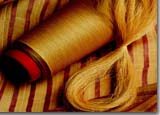


Its production is confined to Assam, border areas of neighboring Northeastern states and Cooch Bihar in West Bengal. It is produced by the muga silkworms (Antheraea assamensis), which feed on Som and Sualu. The most expensive of silks, muga is intrinsically woven into the cultural traditions of the people of Assam. The vibrant Sualkuchi sarees and mekhla-chaddars are the traditional items made from muga silk. In recent times, fashion designers have found exciting prospects in using muga silk for developing new products and designs. Use of muga yarn as a substitute for ‘zari’ in sarees is finding favour with reputed weavers.
- VANYA SILK INDUSTRY IN INDIA
History:
Vanya sericulture remained obscure for a long time as an exclusive craft of tribal and hill folks inhabiting the Central and North Eastern India. It is in the recent past that this tribal tradition assumed importance and attracted attention at National level. The rich production potentialities within the country, steady demand for vanya silk products outside, eco-friendly nature of the production and processing activities, women participation, promoted commercial exploitation of this craft, which culminated in the transformation of this age old tradition to an industry of immense potentiality. Vanya silks have been commercially exploited way back in 17th Century. The Western World gained an appetite for these alien shaded silks in mid 1800 when a rampant silkworm disease destroyed the European sericulture industry. Asia could not supply enough mulberry silk to cater to the needs of Europe and North America, thus creating a market for vanya silks.
Tasar: Though there is no recorded document available regarding the origin of tasar in India, one can find the mention of tasar silk in ancient epic Ramayana "Ram’s nuptial gift to Sita includes tasar silk". Temperate tasar is of recent origin and was introduced during mid 1960's.
Muga: The silk of Assam (Muga) was made known to the World during 1662 through a famous European traveller Jean Joseph Tavenier. Sericulture was exempted from payment of land revenue as the Kings of Assam patronised the development of sericulture. Around 1950, there was a great earth quake in Upper Assam and the large number of muga plantations was destroyed, which hampered the growth of muga industry.
Eri: The word eri means castor plant, is derived from the word "eranda" of Sanskrit origin. The advent of Ericulture is lost into the antiquity but, the fact remains that Assam was the original home of eri silk from time immemorial, with the earliest reference documented in 1779. The Britishers called it as "Palma Christi" silk. The eri silk was woven into heavy clothes known as "Bar Kapoor". Captain Jenkins (1771) remarked that eri silk was of incredible durability.
Distribution of Vanya Silk Industry in India:
Tasar: Tropical Tasar growing area forms a distinct belt of humid and dense forest sprawling over the Central and Southern plateau, covering the traditional states of Bihar, Jharkhand, Madhya Pradesh, Chhattisgarh, Orissa and touching the fringes of West Bengal, Andhra Pradesh, Uttar Pradesh and Maharashtra. Temperate tasar (oak tasar) extends from the sub-Himalayan region of Jammu and Kashmir in the West to Manipur in the East covering Himachal Pradesh, Uttarkhand, Assam, Mizoram, Arunachal Pradesh and Nagaland.
Muga: Assam accounts for more than 95% of the muga silk production. The culture is also spread in different districts neighbouring Assam in Meghalaya, Nagaland, Manipur, Mizoram, Arunachal Pradesh and West Bengal.
Eri: Eri culture was mostly confined to the Brahmaputra valley of Assam in the tribal inhabited districts, followed by Meghalaya, Nagaland, Mizoram, Manipur and Arunachal Pradesh. Ericulture is introduced on a pilot scale in States like Andhra Pradesh, Tamil Nadu, West Bengal, Bihar, Chhattisgarh, Madhya Pradesh, Orissa etc.
Status of Vanya Silks in India:
1. Production trends: Of the total raw silk production during 2010-11 (23,060 MT) Vanya silk contributes to around 20.58% (4748 MT). Of the total vanya silk production, contribution of Eri, Tasar and Muga silks are 64%, 33% and 3% respectively. Vanya silk production which was around 254 MT during 1950 gradually increased to 4748 MT during 2010-11 registering about 18 fold increase over 6 decades.
2. Marketing of Vanya silk cocoons and yarn and products: Though the marketing of Vanya cocoons in general and tasar cocoons in particular is monopolised by the cocoon traders. In the last two decades establishment of Raw Material Banks (RMB) in Vanya sector by CSB, Cocoon markets by Dept. of Sericulture and State government marketing agencies viz., Sericulture Federation (SERIFED), Khadi Village Industries Commission (KVIC), Tribal Federation (TRIFED) etc., have helped in marketing of cocoons. Establishment of these agencies has resulted in improvement in the bargaining power of primary cocoon producers. The Vanya silk products mainly sarees and fabrics for dress material and furnishings are being marketed mainly by manufacturers and traders by participating in various exhibitions all over India.
3. Export of Vanya silk products: The Vanya silk fabrics are being exported mainly from Kolkota, Bhagalpur New Delhi, Mumbai and Bangalore by the established exporters.The share of export earnings by Vanya silk products is approximately 10% out of total export of natural silk goods.
- VANYA SILK MARKETING PROMOTION CELL (VSMPC)
Introduction
Marketing is a systematic approach of understanding prospective customer and their requirement, getting the things ready, exchanging or delivering the goods/ services to the satisfaction of the customer in a profitable manner. It also includes development and maintenance of relationship with the customer which continues even after the sale is over. The products are being developed or produced keeping in view the requirement of market. Various methods are adopted by the traders to market a commodity based on its availability and demand. However, some of the commodities require special treatment so far as their marketing is concerned due to their limited base and also their clientele. The Vanya silk products fall under this category. Muga, Tassar and Eri silkworms are not fully domesticated and we call the silks they produce as wild silks or Vanya Silk. They are basically rural produce and their handling require special care as the problems involved in the marketing of rural produce are entirely different that of urban specific and industrial products. The marketable Vanya Silk products comprise silkworm seed, cocoons, raw silk, spun silk fabric and end products like sarees, garments, made ups etc. Out of these, fabric and other end products are the only consumer articles in strict sense. The process of marketing is intricate and demands regular market research and intelligence to develop different sets of marketing strategies that suits the different products when producers and consumers come from different background as in case of Vanya silk products.
Chattisgarh and adjoining states like Jharkhand, Madhya Pradesh, Bihar, Orissa and West Bengal states produce Tasar cocoons. Muga and Eri cocoons are largely produced in Assam and adjoining states of north eastern region. U.P., Himachal Pradesh, Uttarakhand and J.K. also contribute the production of Vanya silks which is not very significant. Unlike existing marketing systems for mulberry there is no established marketing system for Vanya silk products. In the existing system, cocoon growers sell their produce to Mahajans and in turn Mahajan gets the cocoons converted into raw silk/silk yarn and then fabric through weavers. Few states have federations or societies for more market intervention of the cocoons for level playing to control the exploitation of the cocoon growers through the Mahajans but its objectives are partially met. Various Non-governmental organizations (NGOs) are also operating in the Vanya silk producing states to provide alternate earning resource to the weaker section of the society.
Till now the slogan for development of the silk production activity was ‘soil to silk’ (yarn). Now, Central Silk Board has gone beyond silk reeling i.e. weaving, development of Silk products, providing linkages for sale of silk products more particularly to the Vanya Silk products by setting up a “Vanya Silk Market Promotion Cell” (VSMPC: - 080 26282621, 26282146 & - vsmpc.csb AT nic.in) under Catalytic Development Programme (CDP) with its headquarter in Bangalore during the year 2006-07. The activities of VSMPC are continued during the XI Plan.
Objectives
- To provide required input support to Vanya Silk (Non – Mulberry) sector in the areas of market promotion in domestic / overseas markets.
- Design and Development of marketable products through research and development and in association with fashion designers.
- Evaluation of existing infrastructure in silk weaving clusters and need based up gradation of looms, training of weavers in advanced production techniques.
- Organizing exhibitions in major metros and non-metro cities and sponsoring manufacturers to participate in domestic and overseas marketing events.
Strategy
- Gathering information on the producers of Vanya Silk - Organizational details, production, production capacities, product range, raw material details, present marketing arrangements etc.
- Gathering information on domestic and export markets for Vanya silk products – the cell will engage outside experts for this purpose if necessary.
- Collect samples of raw materials and finished products from producers in traditional production areas, Museums, Collectors, Master weavers, marketing organizations, cooperatives, NGOs, R & D Institutes etc.
- Evaluation of samples, categorization, preparation of swatches, brochures and material for e-presentation to prospective domestic and overseas buyers.
- Help the Industry in packaging, labeling and presentation of products – the cell will engage experts in the field.
- Creation of e-marketing website for Vanya silks - the cell will engage experts for the purpose.
- Facilitating participation of producers in major marketing events like fairs, expos, exhibitions etc. in the country and abroad.
- Engage designers, merchandisers and other specialists on contract for specific periods.
- Establishing and maintenance of Vanya Silk Shoppees in major cities.
- ACTIVITIES OF VSMPC
Vanya Silk Product Development and Marketing
Generic and Brand Promotion Vanya Silks
Vanya Silk Expos
Vanya Silk Theme Pavilion – Generic Promotion
Vanya Silk Shoppees
Product Launch
Test Marketing of Vanya Silk Products
Vanya Silk Directory
- VANYA SILK COCOONS
Types Unit of Measurement TASAR Oak Tasar The unit of measurement of tasar cocoons for transaction is Kahan. The number of tasar cocoons per Kahan differ in different states.
Kahan contains 1280 cocoons - in Bihar
Kahan contains 1600 cocoons - in Orissa
Kahan contains 1000 cocoons - in M.P.
Kahan contains 4000 cocoons - in MaharastraKAHAN
4 COCOONS = 1 GONDA
20 GONDA = 1 PON
16 PON = 1 KAHAN (BIHAR)
20 PON = 1 KAHAN (ORISSA)Around 1200 cocoons are required to produce one kg of yarn
Tropical Tasar
a) Daba,
b) Raily,
c) Sukinda,
d) Andhra Local,
e) Modal,
f) Sarihan,
g) Laria,
h) Bhandara LocalERI White Eri The Eri cocoons are transacted on weight basis (Kg). The Eri cocoons cannot be reeled as the cocoons are open ended. The Eri cocoons are hand spun/ mill spun after degumming and opening. Brick Red Eri MUGA The Muga cocoons are transacted in thousand numbers (‘000). 5000 cocoons are required for production of 1 kg. of Muga Raw Silk.
- VANYA SILK YARNS
- Reeled Tasar / Tasar Raw Silk: It is reeled from Tasar cocoons using different appliance. Reeled Tasar is finer in nature.
- Tasar Gicha: Yarn drawn by hand out of Tasar cocoons without any twist.
- Tasar Katia: Yarn spun out of Tasar waste after opening and cleaning.
- Tasar Jhuri: Yarn spun out of uncleaned Tasar waste without subjecting it to opening and cleaning process.
- Balkal yarn: Yarn spun out of tasar cocoon peduncles, after boiling in alkaline solution and opened up.
- Tasar Spun Silk: Yarn spun in the mill out of tasar silk waste.
- Muga Raw Silk: Yarn reeled from Muga cocoons.
- Muga Gicha: Yarn drawn by hand out of muga cocoons without any twist.
- Hand Spun Endi/ Eri Silk: Yarn spun by hand appliances from Eri cocoons.
- Mill Spun Eri Yarn: Yarn spun in the mill from Eri cocoons.
- VANYA SILK FABRICS
- Tasar Fabric: Tasar fabric is normally referred to when reeled Tasar is used in both warp and weft. This Tasar fabric is a popular material for printed / embroidery sarees, gent’s Kurthas and other dress materials.
- T.G.N. (Tasar-Gicha-Noil) Fabric: A combination called Tasar/ Gicha/ Noil is a popular export item. Using reeled Tasar in warp and Gicha and Noil in weft, fabric is woven on handloom in different weight ranges.
- T.G.(Tasar – Gicha): Tasar- Gicha is another popular item in Tasar Silk range and the fabric produced mostly in Bhagalpur and Champa. Reeled Tasar is warp and Gicha in weft is used in this quality.
- T.G.C.(Tasar-Gicha-Cotton): Reeled Tasar X Gicha+ Cotton is a popular silk blend produced by Bhagalpur weavers for export market. Using cotton in place of Noil the fabric woven is similar to TGN on a lesser cost.
- C.G.N./ M.G.N .(Cotton – Gicha- Noil): Cotton X Gicha + Noil is similar to TGN using mercerised cotton in place of Tasar Silk in warp, there by reducing the cost structure. The fabric is quite strong and is mostly used for suiting and furnishings.
- C.G./ M.G.(Mercirised Cotton-Gicha): Cotton x Gicha is another variety of silk blend made in Bhagalpur. Fabric is durable and suitable for dress material and furnishings.
- C.G.C (Cotton-Gicha-Cotton): Cotton x Gicha + Cotton is also produced for export orders. In order to bring down the price considerably, cotton has been used in warp as well as weft with Tasar Gicha.
- Katia x Katia: Katia yarn used in both warp and weft, fabric is produced mainly for export market. Fabric is quit strong and durable.
- Jhuri x Jhuri: Jhuri yarn in both warp and weft, a heavy fabric is produced. Jhuri fabric in different shades is used for upholstery and also for floor covering.
- Muga Fabric: Muga fabric is normally referred to when reeled Muga is used in both warp and weft. This Muga fabric is a popular material for sarees, gent’s Kurthas, Ties and other dress materials.
- Muga Sarees: Muga sarees are the made with reeled muga in both warp and weft along with viscose yarn as extra weft for ornamentation. These sarees are the traditional varieties of North-East mainly produced in Sualkuchi weaving cluster of Assam.
- Muga Mekhla – Chaddar: Muga mekhla chaddars are made with reeled muga in both warp and weft along with viscose yarn as extra weft for ornamentation. These are the traditional dress of North east mainly produced in Sualkuchi weaving cluster of Assam.
- Eri chaddar /shawls: Made of Eri hand spun yarn. The Eri chaddars are thick, warm and good for winter.
The fashion wears, life style products, garments, home furnishings, knitwear products are also made from Vanya silks.
- TIPS ON SILK CARE
Precautions during washing
- Always wash silks in soft water. Add a pinch of Borax or Ammonia, if water is hard.
- Use a good neutral soap in the form of either flakes or solution.
- Light detergent may also be used in the case of hard water.
- Wash in lukewarm water by kneading and squeezing or suction.
- Rinse in warm water 2-3 times to remove traces of soap.
- Add a few drops of citric acid or acetic acid to the final rinse in cold water.
- Silk with doubtful colour fastness may be steeped in cold water with a small amount of citric or acetic acid for 1-2 minutes before washing. Squeeze lightly by hand to remove water.
- Always dry flat, in shade.
Precautions during Ironing
- Use low to medium heat.
- Never spray water to dampen silk before ironing. This will cause water spots on the fabric.
- Silk should always be ironed on the reverse side if still damp.
Precautions for storing
- Store your silks in a clean and dry environment.
- If storage is prolonged, periodic airing and brushing is advisable.
- Protect silk from insects, dust, excessive moisture and light.
- Avoid direct contact with wood.
- Wrap zari sarees in cotton cloth to avoid discoloring of zari.
- Keep silica sachets in storage racks.






